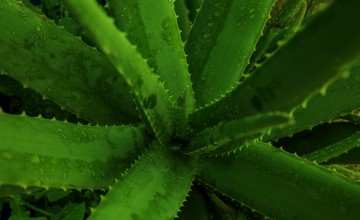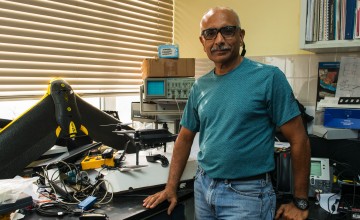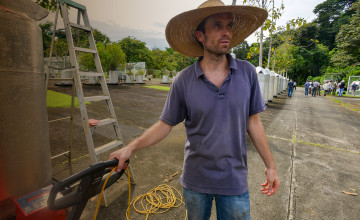
Klaus
Winter
Plants are sessile: they cannot run away when confronted with unfavorable conditions, yet they can adjust the way they function. I have been fascinated by metabolic plasticity in plants ever since I discovered that some species reversibly switch from one photosynthetic pathway (C₃ photosynthesis) to another (CAM photosynthesis) in response to salinity and drought stress.
Projects and Stories
Recent Publications
In situ temperature relationships of biochemical and stomatal controls of photosynthesis in four lowland tropical tree species, 2017
The Kalanchoë genome provides insights into convergent evolution and building blocks of crassulacean acid metabolism, 2017
Research Focus
The Winter lab studies how tropical plants, particularly trees, function and interact with their environment. We explore plant function in the field and under controlled conditions, at the whole organism level and at the level of individual organs, combining physiological, biochemical and molecular approaches. We examine how key processes such as photosynthetic carbon dioxide fixation and associated transpirational water loss are regulated, and how these processes are mechanistically coupled to the acquisition of water and nutrients from soils, as well as to light, temperature, air humidity and the atmospheric concentration of carbon dioxide. The aim is to better understand and predict growth and survival of tropical vegetation under past, present and future conditions, and to explore how functional diversity is linked to the high plant species diversity of tropical forests. The diversity of plant adaptations and correlated acclimation potentials reflect life’s evolutionary history, help to explain distribution patterns, and aid in predicting species responses to atmospheric and climate change. Understanding how plants in the wild cope with environmental stress may facilitate the development of crop plants for cultivation in the world's marginal lands.
Additional links
Contact
How do tropical plants respond to elevated atmospheric concentrations of carbon dioxide and elevated temperatures?
There is uncertainty about the fate of tropical forests in the face of contemporary atmospheric and climate change. My colleagues and I use naturally lit geodesic glass domes and other controlled-environment facilities to simulate future tropical environmental scenarios. We expose plants representing different life forms and functional types to elevated CO₂ concentrations and temperatures. Soil nutrients and soil water availability are additional variables. We measure growth, photosynthesis, respiration, water use, chemical composition and reproduction. These experiments are expected to provide answers to several key questions: (1) Will there be winners and losers among species? (2) Can tropical plants acclimatize? (3) When does climate change reach a tipping point for tropical plants?
How does the tropical forest canopy layer cope with heat, high solar radiation and seasonal drought?
On clear sunny days, especially during the dry season, the tropical forest canopy is a desert environment. When exposed to full sunlight, outer-canopy leaves transiently close their stomatal pores to minimize water loss through transpiration, CO₂ assimilation falls to zero, and leaves heat up. STRI’s two canopy cranes allow us into the forest canopy and to study a wide range of tree and liana species. We use sophisticated portable photosynthesis equipment and chlorophyll fluorescence probes to monitor the physiology of leaves, determine key biochemical processes underlying photosynthesis, and examine how the carbon budgets of leaves are affected under these extreme conditions. Our studies help to unravel the mechanisms of heat tolerance, photoprotection and protection against hydraulic failure in canopy species.
One of the finest examples of metabolic flexibility in the plant kingdom: photosynthetic pathway switching between C₃ and CAM: how, how often, and why has it evolved in tropical plant species?
Studies on Earth’s biodiversity traditionally emphasize the quantitative cataloguing of species and the diversity of morphology. Modern biodiversity studies also address the astonishing functional diversity of organisms. Photosynthetic pathway diversity is a major research theme of the Winter lab, with emphasis on the functional importance and evolutionary origins of the water-conserving CAM (crassulacean acid metabolism) pathway. In contrast to most plants, which display C₃ photosynthesis and sequester atmospheric CO₂ during the daytime, CAM plants incorporate carbon dioxide primarily during the cool of the night when the risk of dehydration is reduced. Nocturnal uptake of CO₂ typically occurs in desert succulents such as cacti and agaves but, as our research has shown, is also a key innovation that has enabled many bromeliads and orchids to occupy periodically dry epiphytic microhabitats in the humid tropics. In the Winter lab, we focus on a hitherto still small, but expanding, number of species that exhibit CAM in an optional, facultative manner. They are C₃ plants when well-watered, switch to CAM when exposed to drought stress, and revert to the C₃ phenotype when re-watered. Species with this special physiology undoubtedly represent one of the best examples of metabolic flexibility in the plant kingdom. We study facultative CAM in tropical tree species of the genus Clusia and, quite surprisingly, have recently discovered facultative CAM in two species widely used as tropical vegetables. While hunting for more species with this remarkable phenotypic plasticity, our principal research addresses three major questions: 1) What is the adaptive significance of facultative CAM under natural tropical conditions? 2) Are facultative CAM species transitional intermediates along the evolutionary trajectory from C₃ to full CAM? 3) How is the physical stress signal translated into the biochemical response, i.e. the shift to CAM, and which genes are upregulated?
Dr. rer. nat., Darmstadt, 1975
Dr. rer. nat. habil., Würzburg, 1983
Winter K, Smith JAC (2022) CAM photosynthesis: the acid test. New Phytologist 233: 599-609.
Winter K (2019) Ecophysiology of constitutive and facultative CAM photosynthesis. Journal of Experimental Botany 70, 6495-6508
Slot M, Winter K (2017) In situ temperature response of photosynthesis of 42 tree and liana species in the canopy of two Panamanian lowland tropical forests with contrasting rainfall regimes. New Phytologist 214: 1103-1117
Crayn DM, Winter K, Schulte K, Smith JAC (2015) Photosynthetic pathways in Bromeliaceae: phylogenetic and ecological significance of CAM and C3 based on carbon isotope ratios for 1893 species. Botanical Journal of the Linnean Society 178: 169-221
Winter K, Holtum JAM, Smith JAC (2015) Crassulacean acid metabolism: a continuous or discrete trait? New Phytologist 208: 73-78
Winter K, Holtum JAM (2014) Facultative crassulacean acid metabolism (CAM) plants: powerful tools for unravelling the functional elements of CAM photosynthesis. Journal of Experimental Botany 65: 3425-3441
Cernusak LA, Winter K, Dalling JW, Holtum JAM, Jaramillo C, Körner C, Leakey ADB, Norby RJ, Poulter B, Turner BL, Wright SJ (2013) Tropical forest responses to increasing atmospheric CO2: current knowledge and opportunities for future research. Functional Plant Biology 40: 531-551
Cheesman AW, Winter K (2013) Elevated night-time temperatures increase growth in seedlings of two tropical pioneer tree species. New Phytologist 197: 1185-1192
Winter K, von Willert DJ (1972) NaCl-induzierter Crassulaceensäurestoffwechsel bei Mesembryanthemum crystallinum. Zeitschrift für Pflanzenphysiologie 67: 166-170


